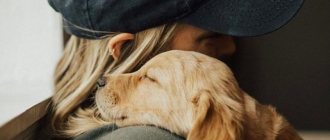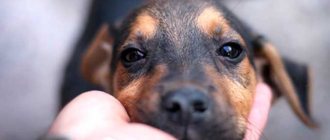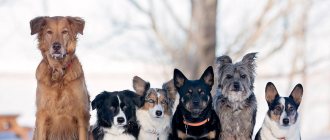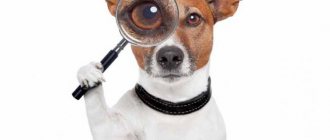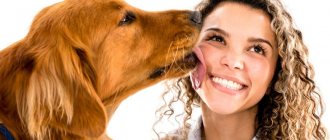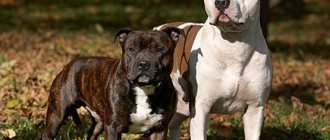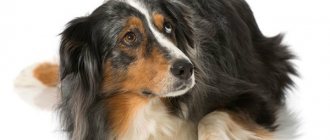If you want to get a puppy, then you should know how a dog chooses its owner in the family.
Dogs have long lived with humans as pets. There are many theories explaining the reason for the appearance of these animals in the house. The most common of them is that a person tamed a wolf, and thereby acquired protection and a friend, and the beast received shelter, food and care.
Did you know that there are breeds of dogs that will not listen to another owner ? These are the 5 most beautiful and unique breeds.
Now it is difficult to imagine the modern world without dogs. Some people are afraid of them, but most treat them with love and respect. When purchasing a dog, it is important to immediately set priorities and let the animal understand who is boss in the house and who should be obeyed. How do dogs choose their owner? How to make your pet choose you as its owner? You will find answers to these and other questions in this article. Read on.
Do dogs choose their owner?
The dog and its owners
The dog's closest relative is the wolf. Animals live in packs, and if for the wolf its relatives become its members, then the dog builds a hierarchy of relationships in the family. Initially, the animal may try to win its place as the boss, but over time it recognizes the strength of the person. The dog really chooses its owner.
There cannot be more than one leader in a pack, so the dog considers as such the family member who initially took the leading position. At the same time, other people living in the house are assigned certain roles. The animal walks with one, the other feeds it, etc. It is worth understanding that even if a dog is friendly with all the residents of the house, it will only obey the one it recognizes as the leader.
At what age does a puppy choose an owner in the family?
A dog in adolescence chooses its owner in the family.
The first months of a dog’s life are the most important period of socialization. She begins to understand the world and her surroundings. Therefore, it is very important at this age to instill in the pet all the necessary attitudes. At what age does a puppy choose an owner in the family?
- It is important to understand that the negative experience of communication, if there was one, will remain with the dog for the rest of its life. For example, a person who offends an animal while it was a puppy will always be its enemy.
- A very small puppy does not understand which person is in charge. That's why he reaches out to everyone.
- During adolescence - about 5 months, the dog can determine the leader.
A person who spends a lot of time with an animal, plays, fairly punishes, trains and treats deserves respect. No less important for the pet is how the owner behaves with other family members.
Dominant dog. Hierarchical aggression
Dominant dog and owner. Hierarchy in the family. Family socialization and social adaptation of the puppy. Dog behavior disorders associated with incorrectly built hierarchical relationships. "Dominant dog" syndrome. Hierarchical aggression. What to do if your puppy bites.
The dog is a pack predatory animal.
Both the ancestors of dogs and the current individuals are animals with a complex of pack instincts. These instincts have been developed over centuries. Dogs once lived in packs in the wild. Analogues of this are wolves, hyenas, jackals, and wild dogs dingoes. A pack relationship is a wolf or dog-leader, leader. It is determined in the process of relationships between all members of the pack according to the principle - WHO IS STRONGER IS BOSS. Therefore, in a domestic dog, the building of hierarchical relationships in its microsociety (family) will also necessarily manifest itself.
A puppy in the family and its place in the hierarchy.
A small puppy in the table of ranks does not pretend to be anything. After all, he is simply too young for this. Therefore, he meekly obeys all the elders around him. Except for their peers. From about 1.5 months. he begins to perceive the primacy of those around him and evaluate everyone in his environment. This is the period of his primary socialization in his family. It is at this age that the breeder takes him away from his mother and transfers him to a new family. There the process of his adaptation, socialization and education begins. (Or lack thereof.) It is during this period that it is important how future relationships will begin to be built. And don’t look at the fact that the puppy is still small and clumsy. Every day he learns the lessons of the surrounding reality. And he studies in the most intensive way!
For now, his activities are limited to games. If this is a large breed puppy, its size is no longer so small, and its motor activity is off the charts. Therefore, already at this stage you can wean your dog child from future bad habits. For example, throwing your entire weight on your feet. Therefore, the prohibition “Fu” or “No” is one of the first commands, along with the nickname, that the puppy must learn. And while the dominant dog is still “sleeping,” this is very effective.
The puppy is a “personality”.
By three months, your pet is already an immature, but already developing personality. With certain inclinations of character, habits and some first acquired experience. And now this person’s ancient pack instincts are awakening. After 3 months, the little dog begins to determine for itself its niche of hierarchical relationships in the family. And here educational measures sometimes begin to be urgent. Because delay, although not like death, often causes serious problems in the future. If you miss the moment.
In general, the innate inclinations of puppies are different. There are individuals who are quite driven, submissive, and calm. But there are – and this is not at all uncommon – puppies born with the makings of leaders. This is exactly what we are talking about now.
Pack instincts.
Lack of proper restrictions from 3 months. begins to appear a little later - after 5-6 months. But these are no longer just manifestations, this is ALREADY A PROBLEM! Which requires not just education, but very persistent correction. What does it look like?
The puppy begins to climb the hierarchical ladder. First, the dominant dog begins to subjugate everyone around him in turn, except the owner, whom he considers the leader. If he succeeds, it’s the owner’s turn. First, obedience disappears. Then, if the most decisive measures are not taken, hierarchical aggression appears. And the further, the more. And the more difficult it will be to deal with it later.
A dog can become the leader of the family.
Having imagined himself to be the leader of the family, a one-year-old monster is capable of turning the life of all family members into hell. In a number of advanced cases, even an experienced canine-animal psychologist will no longer be able to correct the situation. This is especially true for large breeds. Such a dominant dog is clearly aware of its physical superiority and does not hesitate to use it whenever necessary. If family members show fear and powerlessness, the dog begins to manipulate the household. She sets her own rules and practically takes advantage of people. Sometimes it even becomes life-threatening for the weakest members of the family.
Although more often such a leader dog still remains subordinate to the leader-owner, he either ignores the rest of the family members or still tries to subjugate him over and over again.
How does a dominant dog show itself?
In nature, leaders (leaders who have defeated other similar individuals) among dogs are, as a rule, males. Although bitches also have the makings of leaders, they will only manifest themselves in the absence of a male leader. It is easy to distinguish them by their behavior in a flock. When feeding, the leader eats the food first, slowly. Everyone else is waiting and doesn’t come up. Until the head of the pack gets enough. Likewise, at home, the dog will growl angrily or bite when family members or even the owner approach at this moment. Dominance also stimulates food aggression.
The leader controls the movement of his flock. He himself chooses a resting place - a bed - from where he can see everyone. At home this will also manifest itself typically. The dog growls and gets angry if its access to a certain room is restricted. Or if you try to drive her away when she prevents you from passing. Either direct hierarchical aggression occurs (on a person) or transferred aggression (on a closed door). During walks, the owner’s obedience is practically absent. Returning from a walk, such a dog will pull on the leash, trying to be the first to get through the front door.
Small "dominant dog" syndrome.
Unlike large working breeds, smaller dogs can also develop it. But it doesn’t have to manifest itself in the form of aggression. This can be expressed in capriciousness, cunning, minor dirty tricks and the need to attract increased attention. Often this syndrome develops in the absence of the owner's attention to the dog. When the dog is most often simply forgotten, he has the illusion of permissiveness. But the owner’s refusal to make important decisions, blaming it on the pet, leads to stress and neurosis.
What mistakes in upbringing contribute to this?
In fact, these are two extremes in education.
1. Permissiveness and spoiling. The owner indulges all the whims of the little pet. Pranks turn into unpunished hooliganism. The dog's behavior changes very quickly. But the dog gets away with everything... Until he - in the first option - discovers that he is already stronger than everyone else and really more important than everyone else! A real dominant dog .
In the second option, the owner comes to his senses and decides that it’s time. It's time - WHAT? He doesn't really know what to do. He just knows that something needs to be done, otherwise that’s it, guard. And he begins to use force. As a result, it either aggravates the situation (hierarchical aggression can only intensify). And in the end he decides to get rid of the pet. Or he gives up... And no longer has any power over the pet.
Sometimes he can get his way. Having broken the psyche with beatings and bullying. But in any case, this is a complete loss of contact with the dog, the remnants of trust and, as a result, mutual hostility. After all, the dog doesn’t understand why yesterday everything was possible, but today suddenly nothing was possible. As a result, there is only one way for a dog to protect its hierarchical niche - retaliatory aggression.
2. The owner seeks to completely suppress the pet. Constant punishment, inconsistency, drill, stress. They are actually trying to force the dog into the outcast's niche. This is fraught not only with loss of individuality, but also with retaliatory aggression. Or other behavioral problems. But the makings of a dominant dog still haven’t gone away. And, sooner or later, this will come out in an already matured dog. But there will be no talk of any love for the owner.
How to avoid hierarchical aggression in a leader dog?
The main principle is balance and consistency of education.
- Timeliness! Moderately harsh punishments for the slightest manifestations of attempts to dominate in EARLY PUPPY age. And not when the dog had already become almost a ready-made leader and began to establish his own rules with his teeth. In different dogs, such attempts may appear at different ages - from 5 months. up to 1 year. When a leader dog begins to emerge, it should be immediately noticed.
- Justice. If you punish, then you absolutely cannot make mistakes and punish undeservedly (“just in case”). Punishment only in case of attempt to dominate. But such attempts cannot be left unpunished under any circumstances. From a very early age, the puppy must clearly understand what he can and cannot do. Prohibitions must be set for him as if he were an adult dog.
- At the same time, the dog should feel the love of all family members. Everyone should have good contact with the dog. For puppies, the most effective thing is not bribery with a treat, but games! However, even during play, you should not allow your puppy to bite.
- The owner must show the dog that he, and only he, is the main leader of the pack! Because either you will become it, or the leader dog will take your place. There is no third. This means that a dominant dog must know its niche very clearly. And that all attempts to dominate and move up in the family hierarchy will be inevitably and harshly suppressed. And immediately and without hesitation. You need to try to teach the puppy to obey all family members.
- When choosing a future pet, you should take into account the characteristics of some breeds. Which are more characterized by innate aggression. It will be like an initial predisposition, superimposed and strengthen the aggressive inclinations of leaders. These are Caucasian and South Russian Shepherds, many Molossians, Doberman and German Pinschers, many representatives of terriers (all fighting breeds) and hunting dogs, in particular, spaniels. This does not mean that they are all aggressors! But in these breeds, innate aggression is more common.
The dominant dog in the family. What rules must be followed?
- Feeding is strictly only in one place, separate from the meals of family members. It is strictly forbidden to give your pet treats from the table. Feeding the dog should be done only after everyone in the household has eaten. That is, the leaders eat first.
- The dog must earn all rewards with treats - and only on the initiative of the owner, not the dog. If a dog begs, it should not be ignored, but pulled back.
- The dog must have his place. At the same time, all other places, such as chairs, sofas, beds, must be strictly prohibited.
- Another action should be impermissible - laying paws on family members and the owner, as well as performing indecent acts at the same time. Because this is a sign of an attempt to show dominance.
- Dog training is mandatory, it is discipline and the basis of obedience. Harsh mechanical training methods are used. Great physical activity.
- Be the first to enter the apartment after a walk, forcing the dog to enter the house only after you.
- If you have a dominant dog, you should not be shy about sometimes using force and severity - within reasonable limits, of course.
- Very young children should not be left alone with such dogs for long periods of time. Hierarchical aggression can appear suddenly.
- If an attempt at dominance is detected in a puppy, another preventive measure is applied. This is tipping the dog onto its back with the owner sitting on top of it. Until all gestures of protest disappear and for some time longer... Individually, depending on the situation.
- Remember that it is much more difficult to re-educate a ready-made leader of the family than to prevent his emergence with proper balanced upbringing.
Games with a puppy with the makings of a leader.
Games are needed. But not competitive ones like tug-of-war or tug-of-war. And more intellectual ones, for example, searching for a toy. Or fetch, provided that the dog gives the owner the brought object (taught by exchanging it for a treat or another toy) on the command “Give”. Games help establish positive connections. Attempts to bite during games, or even growl in the most harmless situations, should also be suppressed in leader dogs. In these cases, a sensitive spank anywhere is necessary. Play and communication in general stop immediately, and all toys are confiscated. The dog must be temporarily locked in a cage or enclosure, if possible.
If the dominant dog is already aggressive.
Correcting the behavior of such dogs begins with changing the behavior of the owner himself. Taking into account all of the above. Forceful methods of influence are possible, but in some cases they are ineffective. Moreover, sometimes hierarchical aggression can increase. With all the consequences for the owner, who was clearly late with this.
As a more effective alternative, short-term strangulation is used to subdue dominant leaders of large breeds. But only experienced specialists know such techniques; an inexperienced owner should not try to use them. More often, the last resort for re-education is the final transfer of the dog to another, more experienced owner.
It is much easier to retrain a young dog than an older one. Often the fate of such aggressive older dogs is euthanasia.
Play aggression.
This is biting in puppies during play. If your dog is a leader, this phenomenon must be eradicated. If not, there is absolutely no point in fighting it. You need to understand that this is not hierarchical aggression at all. And, although the bites can be quite sensitive, their root cause is quite harmless. Trying everything “by tooth” is generally typical for a child, be it a dog or a human. This is part of learning about the world around us. Including during games.
But a 2-month-old puppy playing and biting is one thing. At 6 months after changing teeth and developing chewing muscles, the same biting will be different. And not everyone will like it, even with a completely non-aggressive dog.
If we are at 6 months. If we punish the dog for this, it will be very unclear to him why. Because this was allowed before. Therefore, for large breeds this issue must also be addressed in advance. How? There are several options.
- You need to reorient the puppy over and over again from your limb to the toy, offering to play with it. As a result, soon the puppy will come running to you with a toy in its mouth.
- The effect is similar to that of a lactating bitch. Which the puppy pesters, trying to grab his ear. What does the mother do in response? He grabs him by the scruff of the neck and shakes him hard. The owner can do the same.
- By analogy with a peer puppy. Which the puppy also bites, for example, on the ear. What does the peer do in response? Signals by squealing that he is in pain. Someone at home can imitate the same thing. A puppy who did not intend to cause pain will understand that his efforts with his teeth were excessive and unwanted. But this method will not stop the puppy from biting. He will only teach him to correctly calculate his “dental” efforts.
When this is a dominant dog, there are no questions. But experts have different opinions on whether it is worth fighting play aggression in a puppy without the makings of a leader. But hierarchical aggression requires mandatory correction.
Cynologist instructor Yagovitina Yu.A.
Why does a dog choose one owner?
A dog chooses one owner
A dog chooses a leader not only based on the person’s attitude towards it. In a dog’s understanding, members of a pack (family) are divided into several main niches:
- Alpha . The most important member of the pack, making all decisions and responsible for the offspring.
- Beta. Members of the pack subordinate to the leader, replacing him if necessary.
- Gamma. Young family members, these include children and the animal itself.
- Omega . Elderly family members who need to be protected.
Why does a dog choose one owner? Answer:
- Because pack animals have instincts that there should be only one leader.
- The owner of the dog, as the head of the pack, must fully perform the dominant functions: protect, feed, treat and instruct its members.
- Also, his solutions are always unrivaled. Under no circumstances should you belittle authority or raise your voice at the head of the family in the presence of a dog, especially in puppyhood.
As a dog grows up, it may try to become an alpha. In a flock, gamma individuals claim to be the leader. Young animals cope better with the responsibilities of a leader, because it is easier for them to get food and protect their flock.
How does a dog choose its owner in the family?
A dog and its owner are alike
Everyone knows that a pet chooses its owner in the family at the level of instinct. But how does this happen in dogs?
- You can often see photographs of pets that look remarkably like their owners. And this is quite understandable. In addition to authority, it is important for a dog to have the same energy as its owner.
- An aggressive animal will be closer to an active and strong-willed person, an easy-going dog is more likely to prefer a homebody.
- Under no circumstances should you prove your role to your pet using force. You need to take care of the dog, protect it from dangers, and over time it will begin to protect you.
Joyful tail wagging and licking from head to toe does not mean that the dog considers you to be the leader. This is how these animals express their positive emotions.
How to deal with puddles?
It's normal for your puppy to make puddles when left home alone. At the age of six months, most dogs already know how to endure a walk. But while your puppy is still small, you need to teach him to go to the toilet in certain places.
The easiest way is to buy a playpen and cover it with disposable diapers. If you do not have the opportunity to buy such a playpen, then you will have to cover the floor in all rooms to which the pet has access with diapers.
Praise your puppy every time he relieves himself in the prepared area. Gradually reduce the number of diapers on the floor. Over time, there should be one left in each room.
How to determine and understand who the dog has chosen as the owner in the family?
The dog looks into the owner's eyes
Every family member should take care of the dog. An animal can be friendly with everyone. But how to determine and understand who the dog has chosen as the owner in the family? There are several signs that mean that the pet has chosen a specific person as its owner:
- Eye contact. A dog looks straight into the eyes of someone it respects.
- Co-sleeping. Not necessarily in the same bed, the animal can simply be located nearby.
- Chain yawn . The dog yawns after its owner.
- Toy separation . The pet brings the owner's favorite toys.
- Tactile contact. Dog "kisses", the animal often places its muzzle on the owner's lap.
- Obedience . The leader's commands are always followed.
A dog can fawn on one and bring objects to another. But it is the totality of all the signs that shows whom the animal has chosen as its owner.
There is a simple test to determine which family member a dog considers to be in charge. The dog is seated, the people claiming to be the owner, disperse from it at the same distance, and begin to call at the same time. The animal will run up to the one it considers the leader.
General dog
With an even distribution of responsibilities, a pet often builds a special relationship with each person in the family. For example, she will be happy to walk with one member of the household, and run or play with another.
This is especially true for friendly breeds such as Labradors, setters, and pugs. In fact, no matter how well a dog communicates with people, it has an owner. A kind and playful dog chooses an owner in the house based on the manifestation of love, respect and care, and it does not matter at what age this happens.
The hierarchy in a family can be imagined as a ladder with steps, on each of which there is a person - a member of the pack. At the top is the owner, and below are people who help him or replace him on occasion.
A dog living in a house views the family as a pack, in which there is certainly a leader. If you take a closer look at the cheerful pet, you can understand that he treats his household differently. For example, a dog perceives children as equals, but listens to and respects their parents. But how can you understand who the dog has chosen as the owner in such a situation? It is worth paying attention to how the animal follows commands during a walk. A pet who fearlessly runs away from a person on the street and ignores his instructions certainly does not consider his companion to be a leader.
Determining the leader in a family is quite simple. He most often stays next to the dog, speaks sternly to him and rewards him for successfully completing commands. It is worth noting that a dog that unconditionally obeys one person may behave badly with another - running away, stealing food from the hands and not noticing commands.
It is curious that a dog that is considered “common” can itself take the place of leader among people. She does not allow anyone to approach the food bowl and actively protects her toys and space.
However, not all animals feel comfortable in this role; they often become aggressive, nervous and get sick from stress. Most of the problems of dog owners are related precisely to the hierarchy within the family, so it is important to determine the tasks of household members in advance, this will help to avoid troubles.
What should you do to make a dog choose you as its owner?
The dog has chosen its owner.
The one who will take on all the functions of an exemplary “parent” can become a leader for a dog:
- Will take care
- Develop
- Treat
- Walk
- Be in love
But sometimes you want your pet to choose you as a leader.
Important: At some point, the pet may try to regain leadership; this must be stopped immediately. But, in no case through physical force. It is forbidden to hit a dog, no matter what it does.
The dog has chosen its owner.
What should you do to make the dog choose you as its owner and recognize you as the boss? Here are the tips:
- Go to places unknown to your pet. The leader through unknown territory is the leader.
- Don't show your fear to the animal . Dogs are acutely aware of uncertainty or fear, and a true leader cannot have these qualities.
- Don't let your pet look down on you . Leaders are always larger than the rest of the pack; you should not let her run up the stairs in front of you, as this will make you seem smaller than you really are.
- Follow through . When demanding the execution of a command, do not retreat, because the leader always seeks obedience.
- Play tug of war . The dog will feel that you are stronger than him without showing aggression.
- Don't let your dog become aggressive towards you directly . The animal may get angry and bite the towel you use to dry it or the nail clipper, but not you.
- Be sure to educate and train your dog. You show her your intelligence and experience.
- Stop unwanted behavior . Use soft methods of pressure: a reproachful look or menacing intonations.
- Don't punish your dog for no reason . An alpha is always fair and cannot take out evil on an animal just like that.
- Don't delay approval and blame . Immediately praise for a good deed and punish for disobedience.
- Don't chase the dog . The leader can catch up with a member of the pack only to punish.
Only a person who is confident in his abilities can become a leader. Treat your dog with love, but do not forget about severity, then the animal will recognize you as the leader.
The dog chose another owner: what to do, can this happen?
The dog has chosen another owner.
You bought a puppy, but he does not recognize you as the leader. The dog chose another owner. What to do, can this happen?
- Most likely this happens because you are not the leader in the family.
- Dogs are often bought for children, but the animal treats them as equals, and it is almost impossible to change this.
- Alpha is always the strongest and bravest; all family members obey and respect him.
- Therefore, demanding recognition from an animal is useless.
- Do not forget that dogs, like all animals, live by instinct, feeling the leader and obeying him.
A situation is possible when the dog recognizes you as the leader, but after some time another family member becomes the leader for it. This can happen for several reasons:
- You have seriously offended the animal . For example, they hit you or left for several days. The leader never leaves his pack and does not allow himself to show aggression towards its members.
- Your authority was belittled in front of the dog . For example, they raised their voice at you in her presence or swung at you. Such an attitude towards a leader is unacceptable.
- You are not taking care of the dog. Training, feeding, treatment, walks are your direct responsibilities towards the animal. Having shifted worries to another family member, do not be surprised if the dog recognizes him as the leader.
In general, these animals are very loyal creatures. A change of owner is stressful for them, so having chosen one leader, the animal ceases to consider him as such in very rare cases. But if you offend your dog, you risk not only losing its respect, but also becoming an enemy for life.
How does a stray dog choose an owner and does he choose?
A stray dog has chosen an owner.
Dogs become homeless from birth and because of unscrupulous owners. In the first case, making friends with an animal and taming it will be quite simple. In the second, it is worth taking into account the circumstances due to which the dog ended up on the street. If the previous owner beat the animal and abused it, then faith in people will be greatly shaken. And it is very difficult to restore this trust, but it is possible with affection, care, love.
How does a stray dog choose an owner and does he choose? When an animal from the street gets into a family, it chooses a leader according to the same principles as a teenage puppy who was raised from an early age. The person who is respected, has a strong-willed character and is obeyed in the family, will be the owner for the dog. You will see this by the puppy dog eyes that look at you and the unquestioning execution of commands.
It is also worth considering:
- It happens that the previous owner of the dog died, and the pet ended up on the street.
- In this case, get ready for the animal to feel sad.
- After all, everyone knows about dog loyalty.
- There is no need to be offended or jealous, give your pet time and surround it with care and attention, over time the dog will definitely appreciate it.
Stray dogs are more difficult to train to live with a family than purebred dogs. It will take a lot of patience, time and effort. It is better to take very small puppies, they are much easier to raise.
Important: A dog picked up on the street has difficulty getting used to life in the house, but once it gets used to it, it becomes the most devoted friend forever.
It is not without reason that a dog is believed to be man’s best friend. It is difficult to find a more sociable and devoted pet. You can get a dog if you are confident in your abilities. Get ready for certain difficulties: attempts to gain authority, aggression, damaged furniture. But after going through all the difficulties and taming the animal, you will gain a faithful friend who will never betray or leave. Good luck!
Dogs are a bit of people: rules for living together with pets
Photo: Chris Becker / Unsplash
To take or not to take?
We are often asked by doubters whether it is possible to get a dog if the work schedule is sometimes irregular, and without a dog it is already completely impossible.
Contrary to popular belief that a dog needs care and supervision around the clock, we are confident that a dog can live well even with those who spend all day at work, especially if it is an adult, balanced animal without behavioral problems. True, you will have to think extra about three-day parties: the dog needs to go to the toilet every day, and it’s better not in the middle of the living room. But if, because of the emergency at work, once a week she goes for a walk not according to schedule, but a couple of hours later, nothing bad will happen. And forgetting to feed your own dog is incredibly difficult. He himself will clearly remind you that it is time for him to eat when feeding time comes. And maybe more than once. If a dog has two owners, it usually does an excellent job of begging a bowl of food from the one who comes home from work first, and then “lies” to the second one that the little animal has been starving since the morning and no one gave her a crust of bread. Of course, they do not lie in the literal sense of the word - dogs do not know how to deceive, but they are good at monitoring the observance of rituals. One of them: “When you return home, throw food at the dog.” And it doesn’t matter how many times you come back. How many times have you come back - so many times and throw it away. Of course, this is not worth going through with.
If everything is in order in a dog’s life, it will not be bored waiting for its owner to get home from work. Dogs are supposed to sleep between 12 and 16 to 18 hours a day, depending on their breed, age and temperament. And if they sometimes have an active weekend with squirrel races in the park or duck swims in the pond, there will be significantly fewer problems with leisure time. Therefore, we do not consider being busy in the service to be an obstacle to getting a dog. The only contraindication can be irresponsibility: no matter how you look at it, you still have to walk your pet, take it to a veterinarian and, optionally, a groomer and trainer, earn money to feed it, and devote a certain number of sofa-cuddling hours. So, without going to extremes and fanaticism, almost every independent adult can get a dog. If he wants, of course.
Dogs and small children
Things are a little more complicated when it comes to sharing a dog with small children. Especially for those who, due to their age, are still inclined to stick felt-tip pens into a dog’s nose and conduct tail stretch tests. Very young children get along better with dogs of medium and large breeds. There is no need to buy them a baby Chihuahua - there is a really high risk of missing dog parts. But more durable dogs, such as Cane Corso, Bull Terriers, Welsh Corgi-Pembroke, will become excellent companions for children, or even nannies. Especially if you take not a puppy, but an adult dog, which is known in advance that it is loyal to children.
True, you will still have to explain to children the rules of communicating with animals. Dogs communicate with human cubs a little differently than with adults, because they see them as puppies and communicate in the way elders should communicate with younger ones - in a patronizing and educational manner. Therefore, it is worth teaching your child not to approach the dog when it is eating or sleeping, not to pull its tail and not to stuff it with “forbidden” foods such as chocolate or chewing gum.
How to "play dog"
In most cases, dogs and children get along, get along well, and have fun playing with each other. But you shouldn’t expect that the dog will necessarily be a tireless ball carrier and a spirited runner in a sled. Not all dogs can play in the traditional sense. Sometimes dogs adopted from a shelter or brought up in unfavorable conditions can be difficult to rouse. The owners believe that their dog is just lazy and nothing can be done about it. But in general, dogs are not lazy. And if she lies on the mat all day and is not interested in the world around her even during walks, we can suspect that she has so-called learned helplessness. This condition is similar to depression in humans. And this is a serious reason to turn to behavior correction specialists, and not to classify your pet as a quitter and couch potato.
Dogs are also not born with the ability to play ball and fetch a stick. If the dog came into the family as an adult and did not live up to the expectations of becoming a partner in games, he will have to be taught games specifically. Or don’t teach, if you are ready to accept the fact that instead of fetching or catching a Frisbee, your dog will sniff daisies and the neighbor’s dogs. And dogs have completely different temperaments. Some dogs are ready to jump up until dawn for their favorite ball, while others will slowly walk to the clearing with a silent plea in their eyes: “Take me back to the sofa.” Depending on their temperament, by the way, and the load, different dogs need different degrees of intensity. And it’s better to think about this at the stage of choosing a breed, so that the desires of the dog and the owner to run or lie around generally coincide.
Photo: Sabina Fratila / Unsplash
Our similarities and differences
By the way, the similarity between dogs and their owners has long become a common place in the culture of Internet memes. And we are often asked: how much human is there really in a dog? Contrary to the stern admonition of old-fashioned dog handlers not to humanize dogs, we are sure that quite a lot. The fact is that dogs and people are almost the same when it comes to the emotional sphere. They, just like us, are capable of feeling joy about a delicious meal or sadness about the end of a walk. At the same time, any self-respecting dog understands the mood of the owner, and an attentive owner perfectly determines how his dog feels. This similarity made the coexistence of dogs and humans pleasant and mutually beneficial. Dogs really understand a lot about us and adapt to us perfectly. Without a little humanity this would not be possible.
Fortunately, they are also quite different from us, otherwise we would not be so interested in them. For example, they do not have abstract thinking, conscience, morality, or the concept of good and evil. For this reason, dogs cannot feel guilty, take revenge, or think about the past or the future. This is important to know if you decide to adopt a dog, and here's why.
The biggest and most common mistake inexperienced owners make is punishing the dog after the fact. Let's say, the owner came home from work, and there were scraps of the sofa and pieces of wallpaper everywhere at home. His first reaction is to scold the dog or at least ask in a scary voice: “Who did this?” So, due to the lack of abstract thinking, the dog does not remember who did it. Well, she doesn’t know how to think about the past, repent and reflect, so she sincerely doesn’t understand why the owner is angry, and tries to calm him down with her dog’s signals of reconciliation. It is these signals that owners often mistake for a “guilty look” and then say to everyone: “Well, the hairy monster knows that he misbehaved, how can you not scold him?” But in fact, scolding a dog after the fact is not only pointless, but also extremely harmful. This makes her nervous and eats away the stress with what’s left of the apartment’s interior.
Did not get along
Despite all the benefits of dogs, life with them is not for everyone. Sometimes it happens that a person and an animal really do not agree in character. Public opinion on this matter always quotes Exupery with his “we are responsible for those we have tamed.” We believe that a person has the right to give into reliable hands a dog that is objectively not suitable for him. This will be better for everyone, because the dog will not find himself in an atmosphere of unloving, and the owner will not be mired in feelings of guilt due to the fact that he cannot give the dog everything he owes. If such a situation arises and attempts to get closer to the dog are unsuccessful, it is important to be responsible to the end. That is, do not tie the dog to a birch tree in the forest, but find a suitable family for it and properly prepare the relocation.
Preparation is important because moving into unfamiliar conditions with unfamiliar people is very stressful for a dog. You can minimize it like this: 3-5 days before hour X you need to start paying less attention to the dog: do not play with it as before, take it outside only for hygienic purposes and, if its health allows, do not feed it. This is necessary so that after the move, the new owners can arrange a real holiday for the dog with chases through the forest, a buffet and hugs. This way he will experience the separation less painfully, although he will still look for his old owner on every walk for several more months and walk around sad. In order not to disrupt the habituation program, the old owner should not visit the surrendered dog for at least six months. Without seeing him, she will quickly become attached to the members of the new family. There is also no need to arrange a stormy farewell with tears when parting. The dog will not appreciate it, but will only get more excited. Just collect all his things and take him to a new place. Familiar smells from things will be an additional support for him.
But, if you have doubts about whether you should give the dog away, you can always try to get closer to it. This is where turning to specialists who specialize in positive training or dog behavior experts can sometimes help. Perhaps the problems that made you think about giving up your dog will be easier to solve than you thought.
Prepared by Anastasia Stepanova
